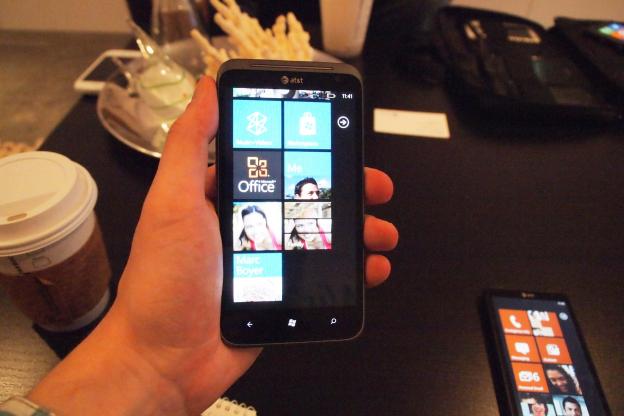
Though there weren’t dozens of new Windows Phones shown at the Consumer Electronics Show this year, Microsoft may have had a more impressive showing than Android. Nokia finally debuted its first 4G LTE Windows Phone 7.5 device, the Lumia 900, and HTC quietly announced a sequel to its newly released 4.7-inch Titan phone. Oddly, the manufacturer didn’t have a presence on the show floor, but Microsoft let me play around with one during our Windows Phone meeting. My impressions are below.
A more stylish design
From a design perspective, the Titan II is quiet similar to its predecessor, but HTC has improved the look of the shell with a few lines and curves. The new design looks very similar to the HTC Sensation, an Android phone that hit shelves in the middle of last year, and a lot of HTC’s lineup since.
If you’ve held a Titan, then you know how the Titan II feels. Both phones have a huge 4.7-inch screen (about the same size as a Galaxy Nexus, though ever so slightly larger) and a camera that protrudes from the back just a bit. We’re not a huge fan of a stick-out camera, but I’ll address that in a bit. The Titan II is slightly thicker than the original, as you can see below. Much like the Galaxy Nexus, these phones are usable, but we wouldn’t want a device much bigger than this. Already, I have to stretch my thumb quite a ways to do anything on the upper or lower left side of the screen. If you hold phones in your left hand, reverse that problem.
4G LTE, finally
The Titan II isn’t dual-core, unfortunately. Windows Phones still haven’t breached that barrier, though we expect Microsoft to begin allowing more powerful processors in the coming months. But the Titan (along with the Lumia 900) does operate on AT&T’s 4G LTE network, which may is enough to tide us over for now. No Verizon release date has been announced, but it would be great love it if Verizon got on board the WP7 train a bit.
A 16-megapixel camera
I thought the 12-megapixel camera on some of the Fujitsu phones was impressive until I took a look at the Titan II. I didn’t get a chance to give the camera a proper test, but I did snap a few pictures and it appears to be at least on par with other recent HTC devices, which have had some of the best cameras on the market outside of the iPhone 4S. Like the Amaze 4G and myTouch 4G Slide on T-Mobile, the Titan II also comes with a wide-angle lens, a number of advanced filters, a “Burst Mode” for taking a bunch of pictures in a row, a panorama mode, and others. However, it still retains the same simple look and design that all Windows Phone camera apps have. Like all WP7 devices, the Titan II also has a full camera button, which can be activated without unlocking the phone—a useful feature. An upcoming Sony Xperia phone has mimicked this feature, but Windows Phones still seem to do it best.
A good phone
It may be too big for some, but with a fast 4G LTE connection and an impressive 16MP camera, the Titan II is looking like a great choice if you’re on AT&T. It will be even better if and when Microsoft updates Windows Phone to allow more flexibility in homescreen modification. With such a large screen, it would be nice to be able to fit more information on it than Windows Phone 7.5 currently allows. Still, it’s hard to complain, as it’s still a step up from Android and iOS in a number of ways. The HTC Titan II will be released on AT&T in the coming months for a price we expect to be between $200 and $300 with a two-year contract.




